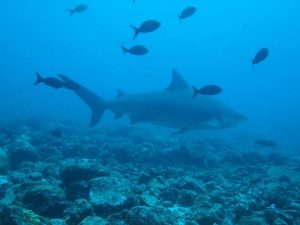Isla de los Murcielagos, Costa Rica
 Bull sharks. If there’s one 12 foot/3.5m, jaw dropping reason (hold on to your reg) to take the 30 mile journey to the Santa Rosa Marine Park on the north west Costa Rican pacific coast it’s for Las Islas de Los Murcielagos or ‘The Bat Islands’ to swim with bull sharks. Existing between 15–30m/50 – 90ft of water they use the 3 cleaning stations as a day spa during light hours and by night they hunt the large groups of trevally, turtles, rays and other fish groups attracted by the currents that the islands create.
Bull sharks. If there’s one 12 foot/3.5m, jaw dropping reason (hold on to your reg) to take the 30 mile journey to the Santa Rosa Marine Park on the north west Costa Rican pacific coast it’s for Las Islas de Los Murcielagos or ‘The Bat Islands’ to swim with bull sharks. Existing between 15–30m/50 – 90ft of water they use the 3 cleaning stations as a day spa during light hours and by night they hunt the large groups of trevally, turtles, rays and other fish groups attracted by the currents that the islands create.
The dive site is called Big Scare and you don’t need to guess why. At the very least it’s completely exhilarating. From your first giant stride entry next to the wall of the solitary pinnacle right up until the 60th time you arrive as a guide. As a well-travelled dive guide of 5 years you can’t say that about too many places. Needless to say it’s for advanced divers – meaning those that can prove a lot of experience (to include deep diving) and not just by presenting an advanced license obtained immediately after the Open Water course. Why? Well; the maximum depths are 30m/90f, there are no lines for ascents, descents and safety stops, currents and swell are often present near the surface and you are 1 hour away from the nearest official medical care. Only experienced divers with a respect for conservative limits and good buoyancy should apply. Nitrox is a good idea if you have good air consumption although normally all air consumption expectations are irrelevant once you’re surrounded by 6 big bull sharks coming in for a closer look at the strange bubble-blowing, awkwardly-moving, mask-wearing creatures that have suddenly moved in to its environment. Keep checking your air because you can reach 700psi in no time.
Bull sharks are part of the Requiem shark family and have a reputation for being the world’s 3rd most aggressive shark. But don’t let this put you off readers. This is mainly because they are one of the few sharks that can adapt to fresh water and swim into rivers to hunt in murky conditions in countries where people survive on resources from the same riverside environment. They are called Bull sharks because of their bulky appearance. Attacks from bull sharks are extremely rare and if attacks occur it’s mainly in low visibility or provoked by chumming activity. That said they are unpredictable and caution and total respect should be obvious treatment. These animals are awe-inspiring and it’s a privilege to be accepted into their world.
On the main Island there is a ranger station and view point to visit. It’s stunningly isolated. It’s possible to camp there and dive at a few of the other dive sites around the Island where it’s also possible to see Giant Manta Rays, turtles, rays and whale sharks if you’re really lucky. In May- September the water temperature is between 25 – 30c, 73- 85f and visibility can unpredictably be anything between 5m- 30m, 20 – 90ft.
If the sharks are not seen (about 30% of the time) it is still possible to see Giant Manta rays that seem to suddenly block out the sun like an aeroplane gliding overhead. Big schools of snapper and jacks impress. There IS macro to speak of but don’t waste too much time looking down unless the Chromodoris Magnific Nudibranch is more interesting to you than a bull shark passing by. You’re likely to see pods of dolphins riding in the wake of the boat on the journeys to and from and later in the season (September/October) we regularly encounter humpback whales playing by the boat. On a good day the only thing I imagine that would make it better would be to have Sir David Attenborough, of BBC Blue Planet, narrating the wildlife behaviour through a public address system on the bow. I’m sure he’s got better things to do, but it’s honestly that good.
Article written by Laura Tyrrell for ScubaDiveMarketing.com






